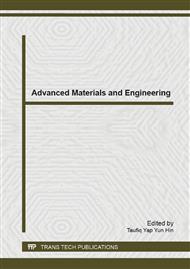p.226
p.233
p.238
p.242
p.246
p.251
p.257
p.261
p.265
Gas Permeation Properties and Characterization of Polymer Based Carbon Membrane
Abstract:
Membrane gas separation is a forthcoming technology that advertised a great commercial potential in diverse industrial applications. Consequently, membrane-based natural gas processing has been among the fastest growing segments of the economic growth. The turbostratic structure of carbon membranes has been affirmed to accommodate with good separation selectivity for permanent gases. With that, the most auspicious technique acquired is by controlling the carbonization temperature during the carbon membrane fabrication. In this study, polymer-based carbon tubular membranes have been fabricated and characterized in terms of its structural morphology and gas permeation properties. Polyimide (Matrimid 5218) was used as a precursor for carbon tubular membrane preparation to produce high quality of carbon membrane via carbonization process. The polymer solution was coated on TiO2 –ZrO2 tubular tubes (Tami) by using dip-coating method. The polymer tubular membrane was then carbonized under Nitrogen atmosphere at 600, 750, and 850 ◦C. The structural morphology of the resultant carbon membranes was analyzed by means of scanning electron microscope (SEM). Pure gas permeation tests were performed using CO2 and N2 gases at 8 bars and room temperature. Based on the results, the highest CO2/ N2 selectivity of 79.53 was obtained for carbon membrane prepared at 850 oC.
Info:
Periodical:
Pages:
246-250
Citation:
Online since:
June 2014
Authors:
Price:
Сopyright:
© 2014 Trans Tech Publications Ltd. All Rights Reserved
Share:
Citation:



